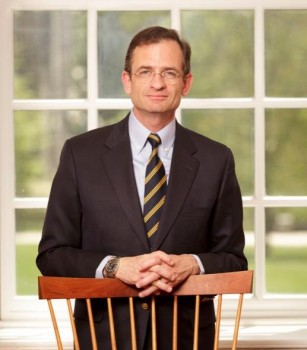President And Professor

Details
Sixteen lucky Tri-Co students have presidents for professors this semester. Haverford College President Dan Weiss and Bryn Mawr College President Kim Cassidy are co-teaching a class,“Higher Education and the Liberal Arts: Mission, Structure and Trends,” with Weiss' Chief of Staff Jesse Lytle. The course, which meets weekly on Friday mornings, alternating between classrooms on the Haverford and Bryn Mawr campuses, examines the distinct roles of residential liberal arts colleges in the U.S. and the major challenges and opportunities facing this type of education, such as affordability and changing demographics, as we look to the future.
“[The class] is a wonderful microcosm of how this place works,” says Weiss.“We have two presidents, the chief of staff, and 16 students in a room talking at a very high level in an open and candid way about serious issues around higher education. We're all learning from each other. It's a great thing.”
The idea for the class began last spring as a collaboration between Weiss and former President of Swarthmore Rebecca Chopp as an extension of the research the two College leaders have done together on the subject of higher ed (which resulted in the publication of last year's Remaking College: Innovation and the Liberal Arts). But when Chopp left Swarthmore for a new job as chancellor of the University of Denver, Weiss' Bi-Co presidential colleague happily stepped in. Over the summer Weiss, Cassidy, and Lytle tweaked the syllabus to reflect the new team's interests, and the course launched this fall.
The three professors are usually at every class, collaborating on leading discussions, though one of them generally takes the lead depending on the topic of conversation.“Dan is wonderfully collaborative,” says Cassidy of her co-teacher.“He has deep knowledge in many areas and expresses his ideas with terrific clarity. I learn a lot from him during the session. It is also fun to engage with him during the class because he's great at asking probing questions and getting the students to examine their ideas.”
Ben Horwitz '17, a student enrolled in the class, says he has enjoyed being challenged to question his own preconceived notions about higher education and has appreciated studying a system in which he is currently enmeshed.“I think that this class reaffirmed many of the beliefs I held about my time at college as an education of the whole person,” he says.“I think Haverford and the people who choose to come here really do a good job at understanding that education doesn't just happen inside a classroom, but that opportunities for learning exist in everyday life and in pursuing interests that might not exactly align with coursework. I also think this course has highlighted that Haverford allows students with a drive and passion for a subject to push that passion into an extracurricular activity, or a thesis, or a collaborative project with a professor.”
Weiss, for his part, is thrilled with how the course is going so far.“The students here, they really are astonishing, they're so smart,” he says.“There are a lot of places where there are smart students, but [these students'] willingness to commit to the enterprise and to invest their own energy, candor, and vulnerability to the work that we do is something I really appreciate. … I couldn't be happier with the chance to interact with all the students.”
So far the class has covered the general history of education in America, the history of the Tri-Co colleges, costs and affordability of higher education, changing technologies, and millennial students. Still to come are units on demographics and diversity, critiques of higher education, collegiate athletics, outcomes and assessments, and the future of the liberal arts.
“My sense,” says Cassidy,“is that the students get most engaged when they see connections between the history and what is happening on campus today.”
For Weiss, an art historian who previously taught at Johns Hopkins before becoming president of Lafayette College and then Haverford, the course is a welcome return to the classroom.“Teaching is at the center of what we do, so getting a chance to be in a classroom with students is not only fun for me, but helps me understand, at a core level, what this place is about,” says Weiss, who will teach a seminar on medieval art in the spring semester.“There's no better way to get to know students. I can bump into them on campus, they can come to my office hours, we can throw the ball around, but when you're in a classroom with students doing that kind of shared learning, there's no comparison to that, so I plan to teach as much as I can. If I were president of a [research] university, it would be something I couldn't do, but I can do it here, and it makes me more useful in my service as president.”
-Rebecca Raber



